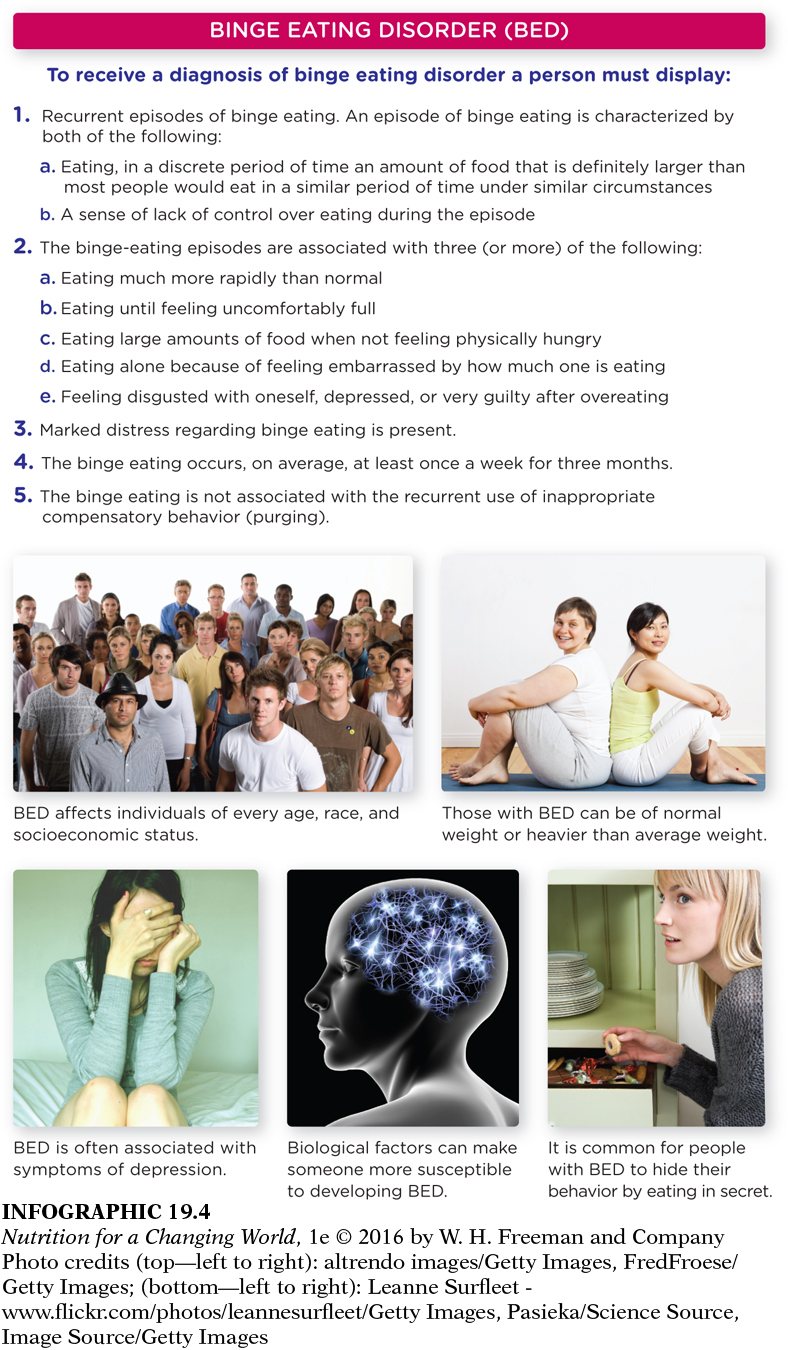EATING DISORDERS
EATING DISORDER an unhealthy and abnormal relationship with food and body weight that threatens health and interferes with many areas of life
When young adults move away from home for the first time, the transition can bring up unpredictable emotions. Indeed, transitions and emotional problems that surface during the college years increase the risk of eating disorders, which are characterized by an unhealthy and abnormal relationship with food and weight that threaten health and interfere with many areas of a person’s life. Eating disorders often arise in response to life stressors or traumatic events as strategies to cope with overwhelming emotions, pressures, or situations.
Eating disorders are associated with emotional and psychological issues such as depression, anxiety, perfectionism, and low self-
ANOREXIA NERVOSA a condition characterized by distorted body image and excessive dieting that leads to severe weight loss with a pathological fear of becoming fat; primarily affects adolescent girls and young women
BULIMIA NERVOSA a condition characterized by frequent episodes of binge eating (at least once per week), followed by purging behaviors to avoid weight gain
BINGE EATING DISORDER a condition characterized by recurring episodes of eating significantly more food in a short period than most people would eat under similar circumstances, accompanied by feelings of lack of control
According the National Eating Disorder Association, the prevalence of eating disorders among college students has grown to 10% to 20% of women and 4% to 10% of men, a much higher prevalence than in any other age group. More than 11 million Americans are estimated to struggle with anorexia nervosa or bulimia nervosa, and an even higher number with binge eating disorder.
Types of eating disorders
BODY IMAGE the way a person perceives their body size, shape, or overall appearance
For each of the eating disorders discussed, the characteristics described are the diagnostic criteria established by the American Psychiatric Association, and are the traits that are most consistently seen in those with the each specific disorder. However, it is important to recognize that there can be significant overlap in the traits displayed by individuals with different eating disorders. For example, those with bulimia nervosa may also exhibit a distorted body image.
Anorexia nervosa, which primarily affects adolescent girls and young women, is characterized by a distorted body image, excessive dietary restriction that leads to severe weight loss, and a pathological fear of weight gain. Approximately 0.5% to 1% of older adolescent girls or adult women meet the criteria for the diagnosis of anorexia nervosa, but prevalence is higher among college women, and there has been a recent increase in prevalence among young women aged 15 to 19. Men account for 5% to 15% of patients with anorexia. (INFOGRAPHIC 19.3)

Question 19.2
 Do you recognize any of these warning signs in yourself or your friends or family?
Do you recognize any of these warning signs in yourself or your friends or family?
If you recognize warning signs in yourself or others, you should visit a healthcare provider or seek information from the National Eating Disorders Association Information and Referral Helpline listed in Infographic 19.3.
Bulimia nervosa is characterized by frequent (at least once a week) episodes of binge eating followed by inappropriate purging behaviors, such as self-
Binge eating disorder is characterized by recurring episodes (at least once a week over three months) of eating significantly more food in a short period than most people would eat under similar circumstances, accompanied by feelings of lack of control. Someone with binge eating disorder may overeat, even when he or she is not hungry. The person may have feelings of guilt, embarrassment, or disgust, and may binge alone to hide the behavior. This disorder is associated with depression and marked distress. It differs from bulimia nervosa in that there is typically no compensatory behavior. Men make up an estimated 40% of patients with binge eating disorder. (INFOGRAPHIC 19.4)

Question 19.3
 Do you recognize any of these warning signs in yourself or your friends or family?
Do you recognize any of these warning signs in yourself or your friends or family?
If you recognize warning signs in yourself or others, you should visit a healthcare provider or seek information from the National Eating Disorders Association Information and Referral Helpline listed in Infographic 19.3.
Newly recognized eating disorders
According to new diagnostic criteria, two new categories of eating disorders include other specified feeding or eating disorder (OSFED) and unspecified feeding or eating disorder (UFED). These new categories are intended to more appropriately recognize and categorize disordered eating conditions that do not meet all the diagnostic criteria for anorexia nervosa, bulimia nervosa, or binge eating disorder. For example, under the new diagnostic guidelines, someone with anorexic features but without the low body weight might receive a diagnosis of OSFED and be eligible for early treatment. These new categories do not necessarily reflect less severe eating disorders—
Although not an officially recognized eating disorder, orthorexia nervosa is a term that has been coined to describe those who have a “fixation on righteous eating.” Individuals can become obsessed with eating “right” and often have rigid eating styles and exercise patterns that affect the quality of their life and relationships, as well as their health. Interestingly, orthorexia appears to be more prevalent among athletes as well as nutrition and dietetics students and professionals.
Causes of eating disorders
The causes of eating disorders are many, varied, and complex. Genetics and predisposition may play a role, as do psychological and personality issues such as coping skills, perfectionism, trauma, and family and social issues. Social norms and cultural environmental factors can also promote unrealistic ideals. The underlying causes or predisposing factors differ for the different eating disorders. For example, individuals who develop anorexia nervosa are often perfectionists, while those with bulimia nervosa may struggle with impulsive behaviors and mood regulation issues. Other common triggers for eating disorders appear to be lack of self-
Eating disorders can also have many symptoms. Depending on the disorder, individuals may show a preoccupation with food and weight; changes in eating or exercise behavior; a distorted body image; abnormal weight loss or weight fluctuations; abuse of laxatives, diuretics, or diet pills; and social isolation and withdrawal. They may also choose to eat alone or be secretive about food and eating. Emotional and psychological signs vary, but they can include difficulty concentrating, poor coping skills, depression, and irregular moods.

Eating disorders can have profound health and lifestyle consequences. They can affect quality of life, relationships, and the ability to function day to day. In anorexia, physical manifestations include severe weight loss resulting in muscle wasting and depletion of fat stores. Hormonal and immune functions are impaired. Individuals suffering with anorexia nervosa often experience dehydration, fatigue, low body temperature, hair loss, demineralization of bone, and, in women, cessation of menstruation. Other symptoms, which include low blood pressure and loss of cardiac muscle, can have dire consequences. In bulimia, electrolyte imbalances can result in life-
With prompt, aggressive, appropriate, multidisciplinary, and compassionate intervention and ongoing support, it is possible for individuals to overcome eating disorders and normalize their eating and exercise behaviors. According to the American Psychological Association, family therapy, cognitive-